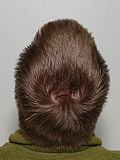Scalp
Scalp
The Scalp is the anatomical area bordered by the face anteriorly and the neck to the sides and posteriorly. It is usually described as having five layers, which can conveniently be remembered as a mnemonic, SCALP: Skin, Connective tissue, Aponeurosis, Loose connective tissue, and Periosteum.
Anatomy[edit]
The scalp is the anatomical area that extends from the external occipital protuberance and superior nuchal lines to the supraorbital margins. The scalp consists of 5 layers: the skin, connective tissue, epicranial aponeurosis, loose connective tissue, and periosteum of the skull. The scalp is usually described as having five layers, which can conveniently be remembered as a mnemonic, SCALP: Skin, Connective tissue, Aponeurosis, Loose connective tissue, and Periosteum.
Skin[edit]
The skin on the scalp is thicker than in many other areas of the body, up to 7mm thick. It contains numerous sebaceous glands and hair follicles. Hair grows from these follicles and is lubricated by the sebaceous glands. The skin of the scalp is also home to a variety of ectoparasites.
Connective tissue[edit]
The connective tissue layer is richly vascularized and contains many fat cells. It is the layer that is primarily responsible for the scalp's ability to stretch and move.
Aponeurosis[edit]
The aponeurosis layer, also known as the galea aponeurotica, is a tough layer of dense fibrous tissue which runs from the frontalis muscle anteriorly to the occipitalis posteriorly.
Loose connective tissue[edit]
The loose connective tissue layer provides an easy plane of separation between the upper three layers and the periosteum of the skull. It also provides a pathway for emissary veins to communicate with the venous sinuses inside the skull.
Periosteum[edit]
The periosteum of the skull, also known as the pericranium, is the layer that is intimately attached to the skull. It provides nutrition to the bone and also serves as a point of attachment for muscles and ligaments.
See also[edit]
-
Double cowlick
-
Layers of the scalp and meninges
-
Gray's Anatomy illustration of the scalp
-
Brain layers
Ad. Transform your life with W8MD's Budget GLP-1 injections from $75


W8MD offers a medical weight loss program to lose weight in Philadelphia. Our physician-supervised medical weight loss provides:
- Weight loss injections in NYC (generic and brand names):
- Zepbound / Mounjaro, Wegovy / Ozempic, Saxenda
- Most insurances accepted or discounted self-pay rates. We will obtain insurance prior authorizations if needed.
- Generic GLP1 weight loss injections from $75 for the starting dose.
- Also offer prescription weight loss medications including Phentermine, Qsymia, Diethylpropion, Contrave etc.
NYC weight loss doctor appointmentsNYC weight loss doctor appointments
Start your NYC weight loss journey today at our NYC medical weight loss and Philadelphia medical weight loss clinics.
- Call 718-946-5500 to lose weight in NYC or for medical weight loss in Philadelphia 215-676-2334.
- Tags:NYC medical weight loss, Philadelphia lose weight Zepbound NYC, Budget GLP1 weight loss injections, Wegovy Philadelphia, Wegovy NYC, Philadelphia medical weight loss, Brookly weight loss and Wegovy NYC
|
WikiMD's Wellness Encyclopedia |
| Let Food Be Thy Medicine Medicine Thy Food - Hippocrates |
Medical Disclaimer: WikiMD is not a substitute for professional medical advice. The information on WikiMD is provided as an information resource only, may be incorrect, outdated or misleading, and is not to be used or relied on for any diagnostic or treatment purposes. Please consult your health care provider before making any healthcare decisions or for guidance about a specific medical condition. WikiMD expressly disclaims responsibility, and shall have no liability, for any damages, loss, injury, or liability whatsoever suffered as a result of your reliance on the information contained in this site. By visiting this site you agree to the foregoing terms and conditions, which may from time to time be changed or supplemented by WikiMD. If you do not agree to the foregoing terms and conditions, you should not enter or use this site. See full disclaimer.
Credits:Most images are courtesy of Wikimedia commons, and templates, categories Wikipedia, licensed under CC BY SA or similar.
Translate this page: - East Asian
中文,
日本,
한국어,
South Asian
हिन्दी,
தமிழ்,
తెలుగు,
Urdu,
ಕನ್ನಡ,
Southeast Asian
Indonesian,
Vietnamese,
Thai,
မြန်မာဘာသာ,
বাংলা
European
español,
Deutsch,
français,
Greek,
português do Brasil,
polski,
română,
русский,
Nederlands,
norsk,
svenska,
suomi,
Italian
Middle Eastern & African
عربى,
Turkish,
Persian,
Hebrew,
Afrikaans,
isiZulu,
Kiswahili,
Other
Bulgarian,
Hungarian,
Czech,
Swedish,
മലയാളം,
मराठी,
ਪੰਜਾਬੀ,
ગુજરાતી,
Portuguese,
Ukrainian




